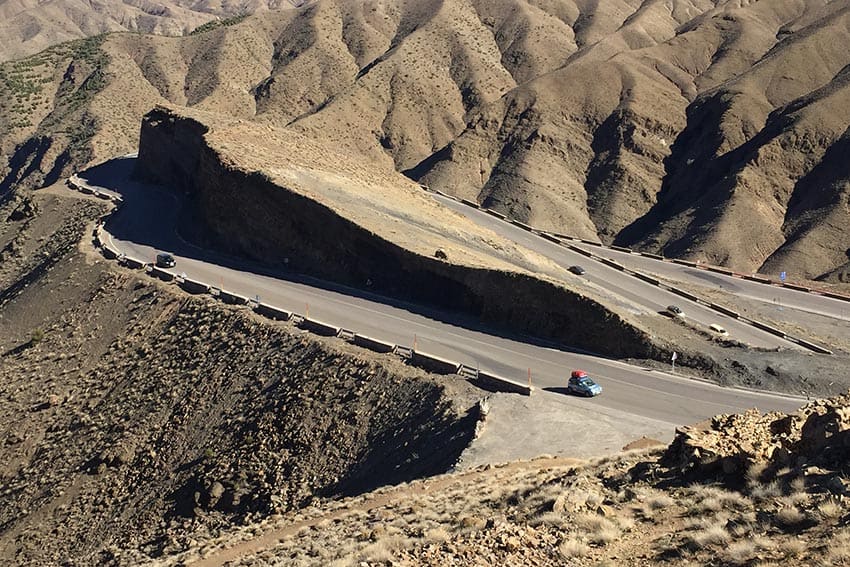
A Moroccan Road Trip Across the High Atlas Mountains
By Leslie Patrick

Like a bag of mixed nuts, we are a curious mixture of tourists.
Tossed together by the gods who preside over tour-package hawking touts, our little group needn’t speak the same language to communicate.
Our language is that of raised eyebrows, gasps, and nervous laughter as our minibus driver passes bus, car, and semi-truck alike on the treacherous mountain roads that snake through the high Atlas Mountains outside of Marrakech in Morocco.
On the Road
Marrakech is a writhing stew of snake charmers, shoe shiners, and street vendors purveying everything from orange juice to baby chameleons, and after six days spent wandering the latticework of alleys that is the medina, my boyfriend Steve and I decided we needed a change.
That’s how we have ended up in this minibus, hurtling at breakneck speeds on roads that should be 20 miles per hour at most, to keep up with our rigorously scheduled day.
The Touma valley is a green swathe of land stretching oasis-like into the emerald distance before muting harmoniously into the blue horizon. On either side of the palm-lined stretch is the red earth of North Africa, spreading east and west like a lateral rainbow.
Our guide tells us that this lush valley is where the Berber people have made their camps for centuries, using the fertile river valley raise livestock and grow olives, maize and wheat before migrating to warmer climes to re-base their camps for the winter.
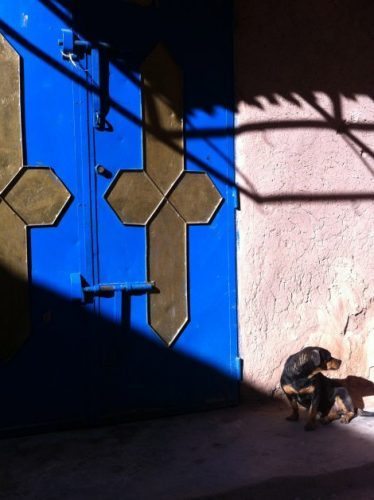
Sampling Argan Tree Wares
The Berber women also cultivate argan trees, the nut of which they use to create an oil used in various cosmetics and food products. A brief stop at a roadside stall gives us a chance to sample peanut butter made from the lugubrious substance.
Thick and viscous and of dubious hygienic standards, I can’t imagine using anything like this on my face, but I smile politely as a young woman explains the benefits argan oil yields to one’s skin.
Back on the road, our little bus sputters its way up to the pass, weaving through rustic mud brick villages filled with scraggly children and grizzled old men, and butcher shops displaying “dead hangy things” as Steve so delicately puts it.
As Morocco is a predominately Muslim country, every remote mountain village clinging to a cliffside is in possession of a mosque.
Decorated in vivid tiles or paint and looking almost grotesquely ornate against the monochromatic landscape, the minarets reach toward the sweeping azure heavens to ensure that Allah does not forget about this dilapidated town in the Atlas Mountains.

The High Atlas Mountains
Patches of snow begin to dot the steeply rising cliffs, and suddenly the road shifts into a mere ledge hugging the side of the mountain.
A haphazardly placed guardrail, about as useful as a spoon on Alcatraz, separates the traffic from a thousand-foot plummet.
I wonder how long it would take a rescue team to find our smashed and mangled minibus at the bottom of a ravine, then decide that’s something best left unthought.
This road trip isn’t one for the faint of heart. High in the Atlas, looking back at the valley below feels like flying, however, the donkey carts and sheep herds our driver swerves to miss bring me rudely back to terra firma.
Suddenly, we stop climbing and reach a plateau, the pass Col du Tichka, which, according to the marker, rises above the earth at 2,260 meters.
The descent on the other side is a circuitous, slightly nauseating route to the outskirts of the vastness of the Sahara Desert.
The Vast Sahara
On this sandy, Martian terrain we come to our first destination, the ancient village of Ait Ben Haddou. A major stop in the old overland trade route between Marrakech and Timbuktu, Ait Ben Haddou looks exactly like a movie set−and what do you know it is.
Scores of movies have been filmed in this Berber oasis, the massive Atlas their backdrop, including scenes from Gladiator, Cleopatra, Kingdom of Heaven, and Prince of Persia.
Climbing through earthen doorways, past donkey pens and small stalls displaying the wares of local artisans, we reach a small structure pronounced the castle, precariously perched on the hill in the center of the village.
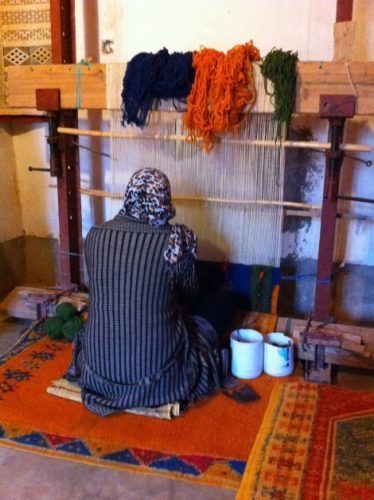
The dry, arid desert stretches out in one direction and the white tops of the Atlas Mountains in the other to create a sweeping canvas of color and history that swirled into a stunning moment where the realization of being in Morocco hits me.
The place had always existed in an exotic fog on the map in my brain, but not as a living, a breathing country bursting with people and camels and majestic mountains springing from the otherworldly landscape.
The heavy wind and my rumbling stomach whip me out of my reverie.
After eating a meal of the traditional Moroccan fare couscous and chicken tagine, our group wanders into a Berber women’s co-op selling hand-woven rugs.
The simple stone building is awash with the vibrant hues of hundreds of rugs, giving it a festive feeling. A woman hunches in the corner, steadfastly working her loom, oblivious to our presence.
The guide explains that the Berber women don’t just haphazardly pick a pretty design, but weave their thoughts and feelings into a carpet, each tiny symbol representing the woman’s hopes and dreams.
Traditionally, the woman presents the carpet to her future husband, and in it, she has woven all of her wishes for their joint future−children, a farm, stability, health−all have a specific, corresponding symbol she has strategically placed in the carpet.
Promoting indigenous women by shopping for gorgeous rugs? I’m sold…especially when I discover that this Berber women’s cooperative in the middle of nowhere takes Visa!
Hollywood of Morocco
Next stop, Ourzazate−a fanciful word meaning “silence” or “without sound.” Our slightly maniacal driver tells us that he was born here, in the “Hollywood of Morocco.”
Indeed, massive movie studios dot the otherwise desolate landscape, and discarded sets lurk in wait of a new film about ancient Egypt or the crusades to be scripted.
We spot a set where parts of The Mummy were filmed and gawk appropriately.
The four-hour bus ride back to Marrakech is subdued as the excitement of reaching the unknown has come and gone. Our driver still passes other cars unabashedly and the cliffs of the mountain are just as precarious, but the hair-raising ride has toughened us up. So this time, when the driver overtakes a tow truck, a smashed-up tour bus it’s an unwieldy charge, nary an eyebrow is raised.
One-day tours to the Atlas Mountains, Ait Ben Haddou, and Ouarzazate can be arranged with myriad companies upon arrival in Morocco, or with toubkalguide.com, a reputable Morocco tour company.
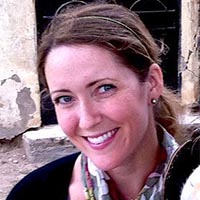 Leslie Patrick is an American-born freelance writer specializing in travel, culture, and lifestyle. Her work has appeared in CNN Travel, Marie Claire, Travel + Leisure Southeast Asia, Islands, AFAR.com, and various in-flight magazines. Leslie is currently based in San Miguel de Allende, Mexico with her husband. Visit her website www.lesliepatrick.com.
Leslie Patrick is an American-born freelance writer specializing in travel, culture, and lifestyle. Her work has appeared in CNN Travel, Marie Claire, Travel + Leisure Southeast Asia, Islands, AFAR.com, and various in-flight magazines. Leslie is currently based in San Miguel de Allende, Mexico with her husband. Visit her website www.lesliepatrick.com.
- Missouri Sports Travel Adventure: From Landmarks to Ballparks - January 21, 2026
- What First-Time Visitors Get Wrong About Visiting Iceland - January 15, 2026
- Bareboat Charter vs all-inclusive Crewed: Which Luxury Charter Fits You? - December 29, 2025



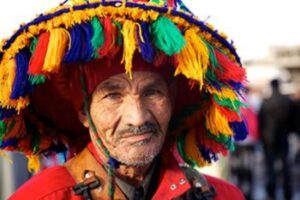
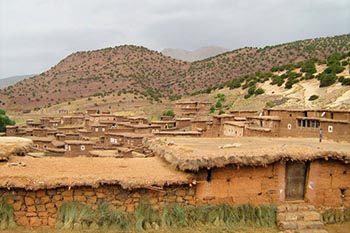

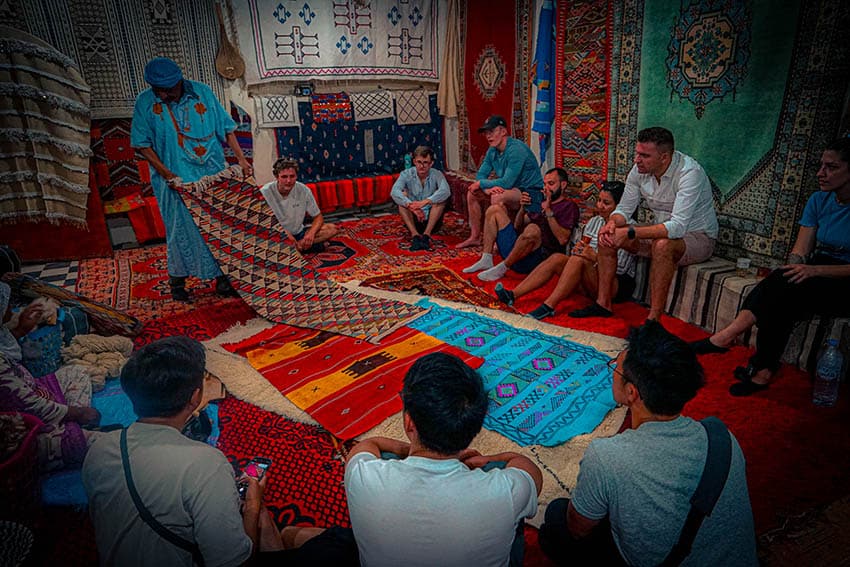

Thanks a lot for your visit and for the article
That’s an amazing trip in the Atlas